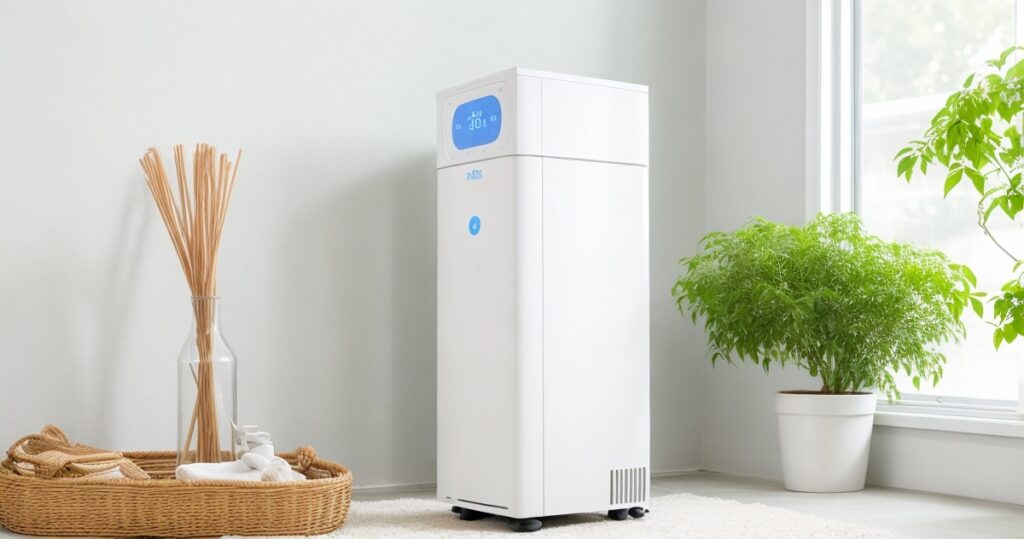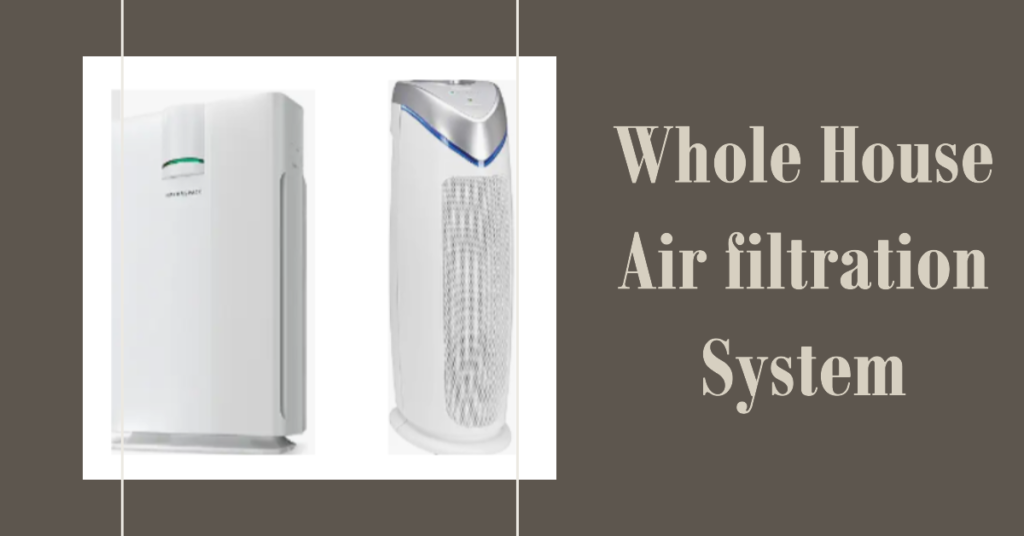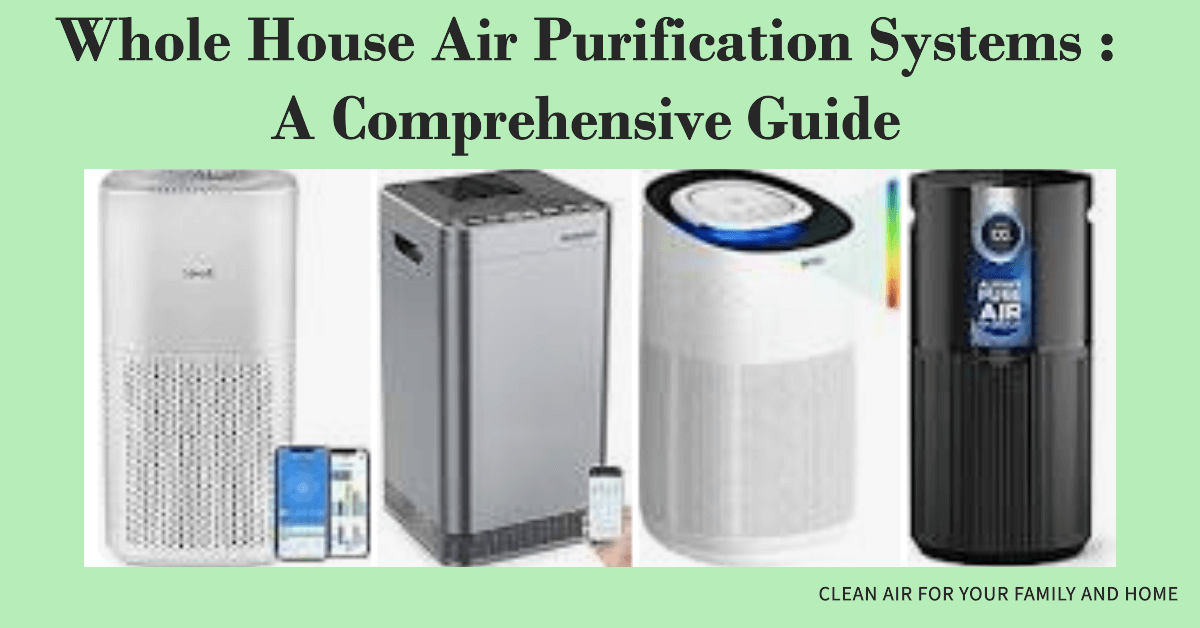Whole House Air Purification Systems are engineered to deliver comprehensive air cleaning solutions for your entire home, ensuring that every breath you take is fresh and free from pollutants. In an era where house air quality is more critical than ever, understanding the significance of whole house air purification systems is the first step toward creating a healthier and more comfortable living space.
Whole house air purification systems are a testament to modern technology’s ability to enhance our well-being. By seamlessly integrating with your home’s HVAC (Heating, Ventilation, and Air Conditioning) system, these systems efficiently remove allergens, pollutants, and contaminants from the air you breathe. From dust and pet dander to volatile organic compounds (VOCs) and microscopic particles, these systems are designed to address a wide range of air quality concerns, making your home a sanctuary of clean, fresh air.
The importance of clean indoor air cannot be overstated. Poor air quality can lead to a range of health issues, including allergies, respiratory problems, and even more severe conditions. With whole house air filtration systems, you’re not just investing in an appliance; you’re investing in the well-being of your family. This article will serve as your comprehensive guide to these remarkable systems, covering their types, benefits, installation, maintenance, and much more. Get ready to embark on a journey towards a healthier, more vibrant life with the assistance of whole house air purification systems.
Understanding Air Quality
Before delving into the specifics of whole house air purification systems, it’s essential to grasp the significance of indoor air quality. Many people underestimate the impact of the air they breathe indoors, but it has a profound effect on health and well-being. Poor indoor air quality can lead to various health issues, including allergies, respiratory problems, and more. It’s not just about comfort; it’s about living in a healthy environment.
Indoor air quality is influenced by a variety of factors, and understanding common indoor air pollutants is crucial. Substances like dust, pet dander, pollen, mold spores, and volatile organic compounds (VOCs) can be found in our homes. These contaminants can exacerbate allergies and respiratory conditions, making it essential to address them effectively.
Poor indoor air quality doesn’t just affect physical health; it can also impact mental well-being and productivity. Studies have shown that cleaner air can lead to better concentration and overall improved quality of life. The need for better air quality is evident, and that’s where whole house air filtration systems come into play.

Types of Whole House Air Purification Systems
Whole house air purification systems come in various types, each with its unique technology and approach to cleaning the air. Understanding these systems is vital in choosing the right one for your needs. Here are the most common types:
| Type of Air Purification System | Description |
|---|---|
| HEPA Filtration Systems | HEPA (High Efficiency Particulate Air) filters are highly effective at trapping tiny particles, making them an excellent choice for allergen and dust removal. |
| UV-C Light Air Purifiers | UV-C light technology is used to sterilize the air by neutralizing microorganisms like bacteria and viruses. |
| Activated Carbon Filters | Activated carbon is excellent at removing odors, gases, and volatile organic compounds (VOCs) from the air. |
| Ozone Generators | Ozone generators release ozone to eliminate odors and microorganisms, but they require caution and proper use. |
| Electronic Air Cleaners | Electronic air cleaners use electrically charged plates to capture particles, making them effective for various contaminants. |
Each of these systems has its strengths and weaknesses, and choosing the right one depends on your specific air quality concerns and goals. Whether you’re looking to remove allergens, eliminate odors, or sterilize the air, there’s a system tailored to your needs.

How Whole House Air Purification Systems Work
Now that we’ve explored the different types of air purification systems, let’s delve into how these systems operate. Whole house air purification systems work by effectively filtering and cleansing the air in your entire home. They use a combination of technologies to achieve this. Here are the key aspects of how these systems function:
- Filtration and Air Circulation: Whole house systems rely on powerful fans to circulate air through various filters or cleaning mechanisms. The air is continually pulled in, purified, and then redistributed throughout your home.
- Elimination of Particulate Matter: Particulate matter, including dust, pollen, and allergens, is effectively captured and removed by the system’s filters or cleaning technology.
- Removal of Odors and Gases: Air purification systems equipped with activated carbon filters excel at removing odors and gases, creating a fresher living environment.
- Sterilization of Airborne Microorganisms: UV-C light and ozone generators work to eliminate bacteria, viruses, and other microorganisms, ensuring cleaner and healthier air.
The combination of these mechanisms results in air that is not only free from particulate matter but also sterilized and odor-free. This translates to a significant improvement in indoor air quality and, consequently, better health and well-being for you and your family.
Benefits of Installing Whole House Air filtration Systems
Installing a whole house air purification system offers a wide range of benefits that go beyond just cleaner air. Let’s explore the advantages of having one of these systems in your home:
- Improved Respiratory Health: Cleaner air means fewer allergens and irritants, leading to reduced respiratory issues and better breathing for you and your family.
- Allergen and Asthma Symptom Reduction: If you or your family members suffer from allergies or asthma, a whole house air purification system can significantly reduce symptoms and enhance overall comfort.
- Enhanced Comfort and Well-being: Breathing clean air contributes to an improved quality of life. You’ll likely experience better sleep, increased focus, and a greater sense of well-being.

But the benefits don’t stop at health and comfort. These systems can also help protect your HVAC (Heating, Ventilation, and Air Conditioning) systems from dust and debris, extending their lifespan. Furthermore, they enhance energy efficiency, potentially leading to lower energy bills.
Considerations When Choosing a System
When it comes to selecting an air purification system for house, several essential considerations should guide your decision. Let’s explore these factors:
- Home Size and Layout: The size and layout of your home play a significant role in determining the type and capacity of the system you need. A larger home may require a more powerful system to ensure even air purification.
- Specific Air Quality Concerns: Identify your specific air quality concerns. If allergies are a primary issue, a system with HEPA filters might be best. For odors, activated carbon filters are crucial.
- Maintenance Requirements: Different systems have varying maintenance needs. Consider the frequency and ease of filter replacement and overall upkeep when making your choice.
Budget considerations are also vital. While air purification systems offer long-term benefits, you should evaluate the initial investment and long-term savings. Consider the return on investment (ROI) in terms of health benefits and energy consumption and efficiency ratings.
Installation and Placement
Installing a whole house air purification system can be a DIY project or handled by professionals. Let’s examine the factors involved:
- DIY Installation vs. Professional Installation: The choice between DIY and professional installation depends on your technical skills and the complexity of the system. Some systems are straightforward to install, while others may require expert assistance.
- Optimal Placement for Maximum Effectiveness: Proper placement is essential for optimal system performance. Consult the manufacturer’s guidelines or seek professional advice for the best placement in your HVAC system.
- Integration with Existing HVAC Systems: Ensure that the air purification system integrates seamlessly with your existing HVAC systems to maintain the overall functionality and efficiency of your home’s climate control.
Once installed, your system will require regular maintenance and care to ensure it continues to deliver clean and healthy air. Regular filter replacement, cleaning, and troubleshooting are essential aspects of system upkeep. These tasks are relatively simple and contribute to prolonging the system’s lifespan.
Whole House Air Purification System Cost and Efficiency
The cost of installing a whole house air purification system varies depending on the type and features of the system you choose. While there is an initial investment involved, it’s essential to consider the long-term savings and benefits.
Return on investment (ROI) for health benefits can be substantial. Cleaner air can lead to reduced medical costs, improved well-being, and enhanced quality of life. Additionally, the energy efficiency of these systems can contribute to lower energy bills over time, further offsetting the initial cost.
When evaluating efficiency, look for systems with high-efficiency ratings. These systems effectively remove contaminants while consuming minimal energy, ensuring both a healthy environment and cost savings.
- Cost:
- Initial Purchase: The cost of the system itself can range from $1,000 to $5,000 or more, depending on the brand, features, and quality.
- Installation: Professional installation costs can add several hundred to over a thousand dollars to the total expense.
- Maintenance: Ongoing expenses include filter replacements and maintenance, which can cost around $100 to $500 annually.
- Efficiency:
- Filtration Technology: The type of filtration technology used (e.g., HEPA, UV-C, activated carbon) impacts the system’s efficiency in removing specific contaminants.
- Airflow Capacity: A system’s ability to process air volume (measured in cubic feet per minute, CFM) affects how effectively it can clean the air in your home.
- Coverage Area: Ensure the system can handle the size of your house to efficiently purify the air in all rooms.
Popular Brands and Models
Now that you’re familiar with the considerations for choosing whole house air purification systems, it’s time to explore some popular brands and models. To help you make an informed decision, we’ve evaluated top systems based on customer reviews, ratings, features, and specifications.
The top 5 brands known for whole-house air purification systems:
| Brand | Description |
|---|---|
| Aprilaire | Known for air purifiers and whole-house air quality solutions. |
| Honeywell | Offers a wide range of air purifiers and whole-house air filtration systems. |
| Carrier | Trusted for HVAC systems and provides integrated whole-house air purifiers. |
| Trane | Offers whole-house air cleaning solutions that work with HVAC systems. |
| Lennox | Provides indoor air quality products, including whole-house air purification systems. |
These brands and models represent some of the top choices in the market. Your final decision should align with your specific needs and preferences, considering factors like home size, air quality concerns, and budget.
Health and Environmental Concerns
As we embrace technologies to improve indoor air quality, it’s essential to address health and environmental concerns. Let’s explore these aspects:
- Air Purifiers and Their Environmental Impact: Some air purifiers produce ozone, which can have adverse effects on the environment. It’s crucial to choose eco-friendly and sustainable options to minimize any negative impact.
- Eco-Friendly and Sustainable Options: Look for air purification systems with certifications or features that emphasize eco-friendliness and sustainability. These systems are designed to minimize their carbon footprint.
- Safe Operation and Potential Health Risks: Ensure that you follow the manufacturer’s instructions for safe and proper system operation. This includes adhering to safety guidelines, especially for systems that use ozone generators.
By selecting environmentally conscious options and following safety practices, you can enjoy the benefits of air purification without compromising on the well-being of our planet.
Air purification system for house in Commercial Settings
Whole house air purification systems aren’t limited to residential use; they also offer substantial advantages in commercial settings. Let’s explore their applications:
- Use in Office Spaces: Air quality in offices directly impacts employee health and productivity. Installing whole house air purification systems in office spaces can lead to a healthier and more productive workforce.
- Benefits for Healthcare Facilities: Hospitals and healthcare facilities require exceptional air quality to maintain a sterile environment. Air purification systems play a crucial role in achieving this goal.
- Air Quality Solutions for Restaurants and Hotels: Restaurants and hotels benefit from air purification systems that eliminate cooking odors and create a pleasant atmosphere for guests. Clean, fresh air contributes to a positive customer experience.
These systems are versatile and adaptable to various commercial environments, ensuring that both employees and customers enjoy cleaner and healthier air.
Whole House Air filtration System Technology Advancements
Technology continues to advance, and whole house air purification systems are no exception. Let’s explore the latest technological innovations in the world of air purification:
- Integration with Smart Home Systems: Many modern air purification systems can be integrated with smart home ecosystems. This allows for remote control and monitoring, making it easier to manage indoor air quality.
- Innovations in Air Quality Monitoring: Some systems feature advanced air quality sensors that provide real-time data on air quality. This data can help you make informed decisions about your home’s environment.
- Emerging Technologies in Air Purification: Researchers and manufacturers are continually working on new air purification technologies. From improved filtration methods to energy-efficient designs, the future of air purification looks promising.
Staying up to date with these advancements can help you make informed choices when selecting a system for your home or business. As technology evolves, air purification systems become more effective and user-friendly.
Comparisons with Portable Air Purifiers
While air purification system for house offer comprehensive air cleaning for your entire home, it’s essential to compare them with portable air purifiers. Let’s examine the advantages and differences:
- Advantages and Disadvantages: Whole house systems provide centralized purification, whereas portable purifiers are localized. We’ll explore the pros and cons of each approach.
- Key Differences and Considerations: Understanding the differences in performance, maintenance, and cost between whole house and portable purifiers will help you make the right choice for your needs.
- Choosing the Right System for Your Needs: We’ll provide guidance on selecting the most suitable system based on your specific requirements, whether it’s whole house or portable air purification.
Both whole house and portable air purifiers have their place, and the choice ultimately depends on the size of your space, your air quality concerns, and your budget.
Conclusion
In conclusion, whole house air purification systems offer a holistic solution for improving indoor air quality and ensuring a healthier and more comfortable living environment. With various types of systems to choose from, you can address specific air quality concerns effectively. The benefits of these systems extend to better respiratory health, allergen reduction, enhanced comfort, and energy efficiency.
When considering a system for your home or business, take into account factors like home size, specific air quality concerns, and maintenance requirements. Popular brands and models are available to cater to different needs, so you can find the perfect fit for your space.
Furthermore, it’s essential to be mindful of environmental impact and safety when using air purification systems. Choose eco-friendly options and follow safety guidelines to enjoy clean air without harm to the planet or your health.
Whether in a residential or commercial setting, these systems play a significant role in creating a clean and healthy indoor environment. As technology continues to advance, we can expect even more effective and user-friendly air purification solutions in the future.
If you’re looking to enhance your indoor air quality and well-being, whole house air purification systems might be the perfect addition to your home or workplace.
FAQ
Are whole house air filtration systems worth it?
Whole house air filtration systems are worth it if you want improved indoor air quality throughout your entire home. They can help remove allergens, pollutants, and odors, making your living environment healthier and more comfortable.
How much is a whole house air purification system?
The cost of a whole house air purification system can vary widely, typically ranging from $1,000 to $5,000 or more, depending on the brand, features, and installation complexity. Professional installation costs may also apply.
What is the best whole house air purifier system?
The cost of a whole house air purification system can vary widely, typically ranging from $1,000 to $5,000 or more, depending on the brand, features, and installation complexity. Professional installation costs may also apply.
Is there such a thing as a whole house air purifier?
Yes, whole house air purifiers exist. These systems are integrated with your home’s HVAC system, allowing them to filter and purify the air throughout your entire house.
Do you need an air purifier if you have HVAC?
Having an air purifier in addition to your HVAC system can further improve indoor air quality. While HVAC filters can capture larger particles, air purifiers are designed to trap smaller particles, allergens, and pollutants, providing more comprehensive air purification.
Does HVAC include air purification?
HVAC systems typically include a basic air filter that can capture larger particles like dust and debris, but they may not offer advanced air purification. To improve indoor air quality, a separate air purifier may be needed alongside your HVAC system.
Is there a downside to air purifiers?
The lifespan of a whole house filtration system can vary depending on the brand and model, as well as how well it’s maintained. Typically, these systems can last anywhere from 10 to 20 years or more with proper care and regular filter replacements.
DheerajSonwane is a dedicated writer with expertise in air purification technologies. He focuses on providing well-researched content to help readers improve indoor air quality in homes and businesses. As the lead writer at AirPurifierMaster.com, Dheeraj offers practical advice his insightful reviews guide individuals in choosing the best air purifiers for their needs.

